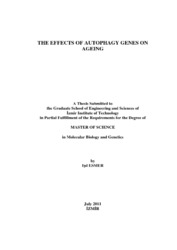Please use this identifier to cite or link to this item:
https://hdl.handle.net/11147/3130Full metadata record
| DC Field | Value | Language |
|---|---|---|
| dc.contributor.advisor | Koç, Ahmet | - |
| dc.contributor.author | Esmer, Işıl | - |
| dc.date.accessioned | 2014-07-22T13:50:56Z | |
| dc.date.available | 2014-07-22T13:50:56Z | |
| dc.date.issued | 2011 | - |
| dc.identifier.uri | http://hdl.handle.net/11147/3130 | - |
| dc.description | Thesis (Master)--Izmir Institute of Technology, Molecular Biology and Genetics, Izmir, 2011 | en_US |
| dc.description | Includes bibliographical references (leaves: 25-32) | en_US |
| dc.description | Text in English; Abstract: Turkish and English | en_US |
| dc.description | x, 33 leaves | en_US |
| dc.description.abstract | Autophagy is defined as a catabolic bulk degradation pathway. In S.cerevisiae autophagy is defined as a single cell's adaptation to starvation. Ageing can be defined as a gradual and progressive deterioration of the health by the time. S.cerevisiae is one of the most important model organism in the field of ageing studies. It has been demonstrated that in different model organisms cellular ageing requires inhibiton of particular nutrient sensing pathways leads to extension or shorten replicative and chronological life span that would be linked by regulation of autophagic pathway. In our study, we screened 29 deletion mutants of autophagy genes in order to determine relation between autophagy and ageing. We found out that 6 mutants showed reduced replicative life span. Furthermore, possible roles of boric acid, as an autophagy inducer was elucidated on replicative and chronological life span. Boric acid did not incerease replicative or chronological life span, in oppose, it shortened life span in a dosedependent manner. Finally, to find out the link between autophagy and oxidative stress, we tested autophagy deficient cells for their hydrogen peroxide sensitivity. Absence of only five mutants rendered cells hydrogen peroxide sensitive. Overall, our results revealed that several mutants of autophagy related paths have shorter life spans compared to wild type cells and cells need to have an intact autophagy systems to benefit from life span extension. | en_US |
| dc.language.iso | en | en_US |
| dc.publisher | Izmir Institute of Technology | en_US |
| dc.publisher | Izmir Institute of Technology | en_US |
| dc.rights | info:eu-repo/semantics/openAccess | en_US |
| dc.subject.lcsh | Aging--Genetic aspects | en |
| dc.subject.lcsh | Autophagic vacuoles | en |
| dc.title | The Effects of Autophagy Genes on Ageing | en_US |
| dc.type | Master Thesis | en_US |
| dc.authorid | TR115223 | - |
| dc.institutionauthor | Esmer, Işıl | - |
| dc.department | Thesis (Master)--İzmir Institute of Technology, Molecular Biology and Genetics | en_US |
| dc.relation.publicationcategory | Tez | en_US |
| dc.identifier.wosquality | N/A | - |
| dc.identifier.scopusquality | N/A | - |
| item.languageiso639-1 | en | - |
| item.grantfulltext | open | - |
| item.fulltext | With Fulltext | - |
| item.openairecristype | http://purl.org/coar/resource_type/c_18cf | - |
| item.openairetype | Master Thesis | - |
| item.cerifentitytype | Publications | - |
| Appears in Collections: | Master Degree / Yüksek Lisans Tezleri | |
Files in This Item:
| File | Description | Size | Format | |
|---|---|---|---|---|
| T000936.pdf | MasterThesis | 689.4 kB | Adobe PDF |  View/Open |
CORE Recommender
Page view(s)
246
checked on Jun 16, 2025
Download(s)
120
checked on Jun 16, 2025
Google ScholarTM
Check
Items in GCRIS Repository are protected by copyright, with all rights reserved, unless otherwise indicated.